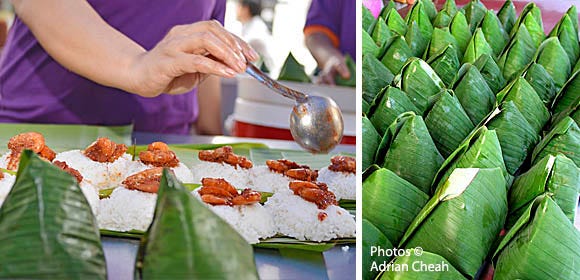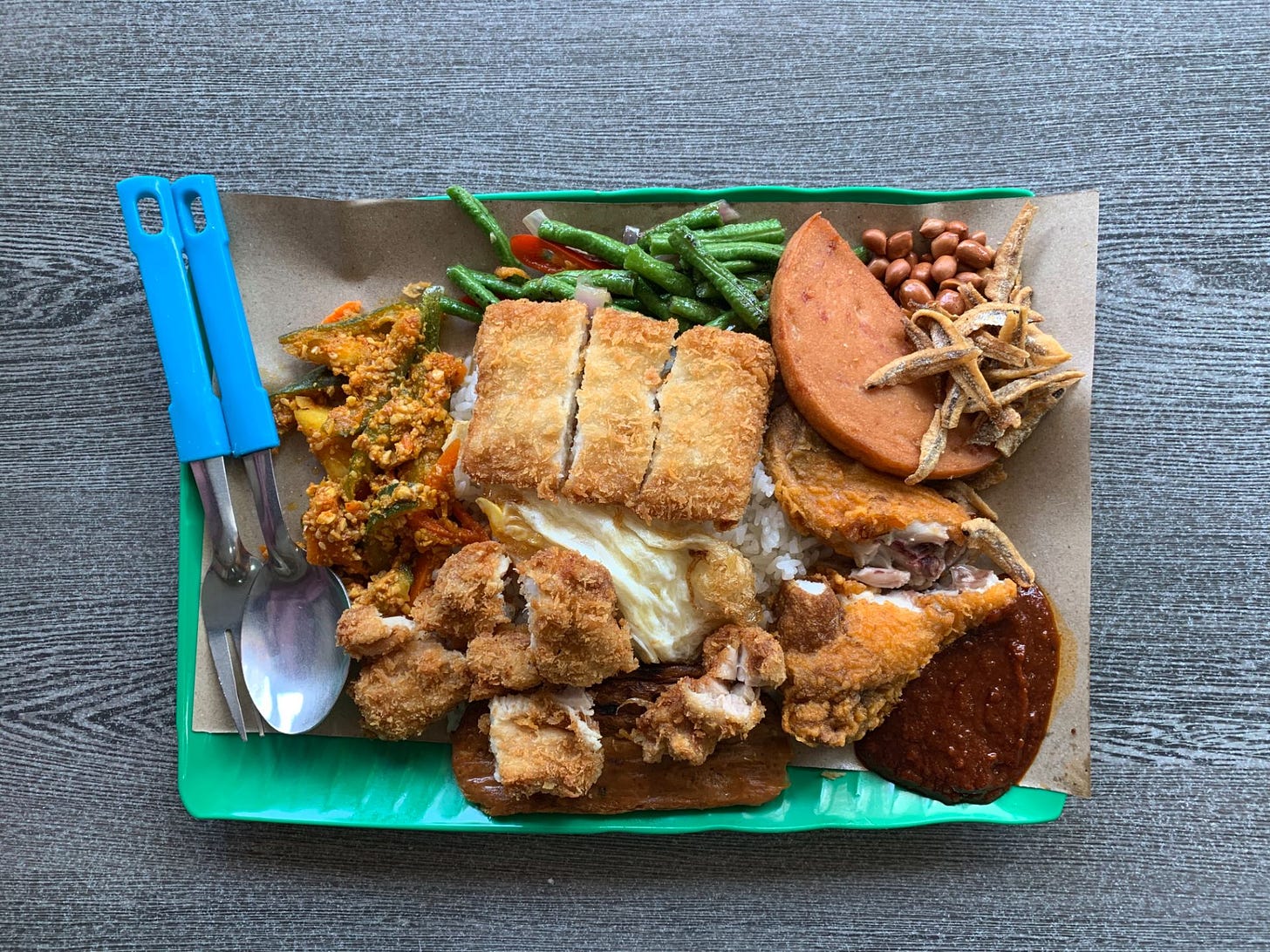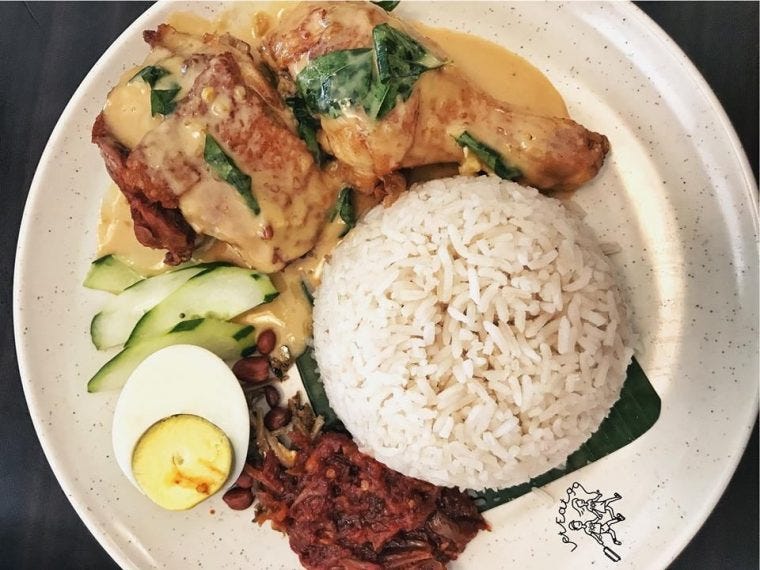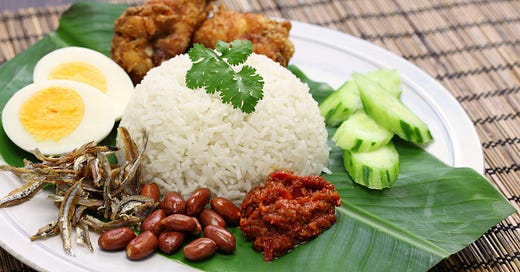How Lemak is your Nasi?
Nasi Lemak is indisputably a Singaporean staple. There are very few dishes that Singaporeans have for breakfast, lunch AND dinner - what's your favourite way to have it?
Nasi Lemak means fat rice, referring to the rich coconut flavour that comes with the rice dish. It also probably was the result of unfortunate bullying by its siblings, fried rice and steamed rice (I joke!). There is no way you can resist an aromatic plate of pandan scented grains, spicy sambal chilli and some crispy accompaniments on the side. In this newsletter, we look at the social status of the famed dish, and some comparisons between types of nasi lemak.
Have you checked out our podcast yet?
Do you know the story of how nasi lemak got its name? It’s a funny one! And how about whether the dish is better in Malaysia or Singapore? We lay that debate to rest. Our latest podcast is full of hilarious stories and surprising facts about the dish that we have all come to love. Check it out now!
The dish that beats inflation

As with most Southeast Asian traditional cuisine, in addition to being delicious, nasi lemak must serve the function of providing energy to the hard workers that toil all day. As far back as in its origin, the nasi lemak dish is supposed to have been put together to support the efforts of the farmers in the coastal villages of western Malaysia1. Even today, when folks are in a rush, whether at a truck stop or on shoot for a film production, the trusted banana leaf pyramids provide the necessary nutrition to carry them through. Nasi lemak is therefore a working man’s meal.
Travel back to the 1970s where these blissful packages went at the roadside for only 30 cents. Accounting for inflation, it is surprising that you can actually still find nasi lemak that goes for a dollar (as in the video above). Many other dishes have seen an increase in price beyond standard inflation rates as they substitute better quality ingredients or account for higher stall rentals, but the nasi lemak has stood its ground.

There could be a number of reasons for this. Some stalls could use it as a loss leader2 to draw customers to purchase other high margin items, others could see it as an altruistic gesture to provide accessible food for the less fortunate among us3. The fact is that the nasi lemak dish is a versatile one, and because it is so imbricated in our culture, gifting a pyramid package can say a lot to the person receiving it. To me, that is very cool.
Which style is the best?
We do not want to start a nasi lemak war but I guess we have to take the risk if we want to explore the diversity of nasi lemak. There is no contest that Malay nasi lemak is the OG and undoubtedly in a class of its own. But as cultures mix, there is bound to be some level of celebration and adaptation. In Singapore, this has taken a couple of forms.
Chinese Nasi Lemak

There are a couple of unique differences between Malay and Chinese nasi lemak. For one, Chinese nasi lemak has a sweeter chilli to satisfy the palates of its customers. It also tends to not only have the presence of non-halal products (such as luncheon meat and sausage) but it also tends to have more deep-fried food in general.4 Malay nasi lemak is supposedly more focused on curries and sambal dishes.
Fusion Nasi Lemak

Perhaps my favourite thing about Singapore food culture is that we are willing to try all sorts of variations and permutations to a dish. We can both honour a dish’s tradition and be irreverent in its future. This has led to all sorts of unique nasi lemak styles in Singapore, including Salted Egg Nasi Lemak, Nasi Lemak Burgers, Nasi Lemak Chips and even Nasi Lemak Ice Cream! I guess if all you need to do is to recreate that familiar oily coconut scent, you can go a long way.
Peranakan Nasi Lemak?

Okay, so we are being intentionally cheeky here, but nasi lemak has had its fair share of controversy. 2020 saw three young chefs, out of the tutelage of the Les Amis group, come into the spotlight for being reported to be selling “Peranakan Nasi Lemak” under their brand, Lemak Boys. The main change was that they had added some Peranakan style ingredients, but the campaign caused a notable social media backlash. It could have been because there was a bit too much of “Peranakan-ising” happening recently, especially following Crazy Rich Asians, but the mis-reported chefs acknowledged that nasi lemak will always have its roots in Malay culture.5
What does this mean for the Singapore identity?
I think it is fair to say that Singapore culture is mostly food culture. The diversity, quality and heritage of our food makes Singapore unmatched, and nasi lemak is another example of why this is so. Just like we shared in the podcast, it is a dish that we will always crave when we are away from Singapore for too long, and it is a dish that can say so much about who we are in this country. From being a meal for the working class to being a meal that crosses generations and ethnicities, nasi lemak and the Singapore identity cannot be separated.
Sources
50-sen nasi lemak a sure-fire way to lure customers - The Star Malaysia
Toa Payoh coffee shop stall has been selling S$1 nasi lemak for more than 30 years - Mothership.sg
Chinese Nasi Lemak Vs. Malay Nasi Lemak. Which is Better? - Rice Media
'We do not serve Peranakan Nasi Lemak': Restaurant Lemak Boys responds to nasi lemak controversy - Mothership.sg




